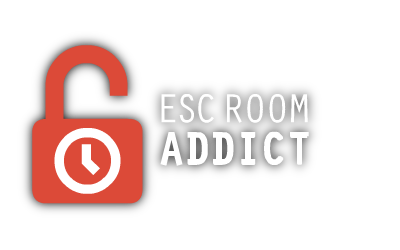EXIT: A Stormy Flight
EXIT: A Stormy Flight
- Played May 2020
- Unlimited
- 1-6 players
- $20 USD (approx)
- Thames & Kosmos
- 1-800-587-2872
- What People Say
‘’It’s so cool you get to travel around North America playing so many different escape games and have people follow your reviews!’’ This is a comment we often receive typically right after we meet someone connected to the escape room community. And yes it’s true, we do consider ourselves very fortunate to have met so many good people, played so many great games, and to have helped tens of thousands of people learn more about escape rooms over these past 7 years… But there’s also a part of being on the Esc Room Addict team that never gets easier. What happens when our team had a rough experience, or didn’t enjoy themselves? Truth be told, there have been many days we wished we weren’t so rigid in our commitment to objectivity and honesty with our followers. It shouldn’t come as a surprise, but it still makes us sad when we see enthusiasts, designers and reviewers trading favourable opinions for popularity. ‘’What?! Nobody does that! The reviews and podcasts I follow are very honest!’’ We hope that’s true, but take for example a conversation we once had with a well known reviewer and podcaster who said: ‘’You think I would actually tell my followers what I REALLY think about the games we play? That’s just nuts! Why would anyone do that?!” Even more unfortunate is when owners and designers do the same. It’s not usually said this bluntly but here’s what one owner once said to us in regards to reviewers ‘’The only reason we invited you guys in was so you could say good stuff about us, and now that you’ve given us a decent review, we’ll take what we need and don’t really need you anymore!’’ It’s from several conversations like these, we came to realize we have a particular responsibility to fulfil in the industry. On the one hand, we’re committed to being honest without exaggerating our good impressions as a trade off for popularity. While at the same time, we refuse to sensationalize negativity (think Simon Cowell and Chef Ramsey), in order to gain followers who are drawn towards angry people. As difficult and unique as our role might be within the industry, so too are our followers! We love the people who follow and support us! They don’t tend to be people who seek fame and recognition… nor do they seek rudeness and anger. They just want to know the pros and cons of what our team members experienced in a game, and as most of you know by now, not even our own team members agree on all things. It’s that strength of diversity (without going to extremes) we love to highlight in everything we do! So with that difficult balance in mind we took a deep breath and opened our copy of Exit: A Stormy Flight.
When the good people at Thames & Kosmos reached out and asked if we could review their two newest games in the Exit series (Stormy Flight and Theft On The Mississippi), we felt honoured… and anxious. The Exit series of in-home escape games are among the most widely sold and promoted within North America. You can find them in just about any board game store, and even some escape room companies. They’re also among the first to try and bring the escape room experience into people’s homes, which is admirable. Counter-balanced to their popularity is that most of their games haven’t received a warm welcome from board game and escape room enthusiasts. It’s been often said the game mechanics, level of puzzle abstractness, and play-testing of the games are in need of improvement. It’s also been observed by many within the industry that other mass produced in-home escape games (such as the Unlock series by Asmodee) have continued to develop, change, and improve over the years whereas the Exit series has remained mostly unchanged. In fairness, (and from a strictly business perspective) it’s not uncommon for a company to assume that increased sales and visibility of a product means customer satisfaction levels are high. But enough preamble, let’s dive in and see what our ERA team members observed about A Stormy Flight and what their experience was like…
The component quality of the game was pretty much what we were expecting. A downloadable app is needed to accompany this game which will provide you with a timer, an ambient soundtrack, and more information about the game. In the box you’ll find various thin paper cut-outs, a small game booklet, a paper game wheel, and of course a bunch of game cards which include puzzles, answers, clues and other needed items for the game. The QR code to access the game app wasn’t functioning properly in our copy of the game which was unfortunate, but when we manually entered the correct internet address it directed us to where we needed to go. The artwork on the box cover was nice which partially helped with our impression. Another nice touch was the tutorial provided within the app on how to play the game. When all things were taken into consideration, it was a decent start with minimal noteworthy pros and cons.
The puzzles within A Stormy Flight were where we felt the game needed the most improvement. In our previous experiences with Exit games, the puzzles and tasks weren’t always intuitive and often required abstract connections. In similar fashion there were many times in this game we were required to think laterally or abstractly outside of the game’s parameters. This can be very frustrating for escape room enthusiasts and new players alike because it opens up too many random possibilities of what an answer could be. As a non-game example: a character says you need to use a key in that lock over there and that’s where you’ll find the next clue. Good news! You already found a physical key earlier that should work right? Or maybe it doesn’t. Why doesn’t it work? Maybe you need to tear the game book in 3 pieces and align the letters K-E-Y together in the top right corner and that will lead to something… Or maybe you don’t have all the information you need yet… Or maybe the answer is to tear the game box in half because there’s a picture of a key on the front of the box… Heck, maybe you just need to flip the picture of that piano over to the other side and see which piano key(s) coincidentally have the picture of the lock on the other side, and now you’ll use the musical notes instead (actually that last idea isn’t too bad… but you get the point). ANYTHING is possible from the destructive and ridiculous, to the absurd, to the lateral and literal (and everything in between)… And what if there’s no direction on which of all these 1000’s of random options is the right one to proceed… or IF you can proceed at all?! With such a limitless mix of literal, lateral, and abstract options (and no clear direction) it’s very frustrating. And yes, like most puzzle enthusiasts we initially enjoyed the first 10-15 minutes of brainstorming on puzzles, but when we kept running into the same pattern of not knowing what to do (or how to solve it), we just felt like quitting. Thankfully the game comes with hints for each puzzle which we relied on heavily… Having said that, there were some things we did enjoy about the puzzles in the game. The puzzles were thematic, they blended with the ambient soundtrack well, and although we would’ve preferred not to have used them, the hint cards were well designed to give increasingly obvious hints (including the answer itself). The puzzle path in this game is strictly linear, and we’d suggest a group size of no more than 2-3 puzzle enthusiasts to avoid the frustration of crowding around the same small cards on a table.
The immersive aspects of the game also had a balance of pros and cons. On the one hand we enjoyed the soundtrack, the consistent theme throughout the game, and the integration of the puzzles into the story… On the other, we felt there were too many times where frustration with the puzzles kept us from enjoying the moment. We also felt the story could’ve been developed better within the game itself – (it’s another example within the industry where the story ending is revealed before you’ve started the game so the puzzles just become busy work). In the end most of us felt there was enough there to be considered an averagely immersive experience for an in-home escape game however.
Did our team members have fun? Well… Remember how we said it’s hard to strike a balance between being honest and avoiding extremes? This is one of those times. The truth is this game didn’t go over too well with our group of reviewers. We tried to get as diverse a perspective with as many pros and cons as we could, but in the end there were too many things that didn’t make this an enjoyable experience. We wanted to like it, and we tried our best to stay positive throughout, but it just wasn’t our cup of tea. The component quality was fine, and the immersive components are similar to most boxed escape games… but the puzzles felt like a tough dungeon crawl grind. Perhaps a different team of puzzle enthusiasts would appreciate the challenge of not having clear direction on how to solve each puzzle. So whom would we say is most likely to find enjoyment in this game? We’d suggest a group of 2-3 puzzle enthusiasts who enjoy abstract puzzles and stretching their imaginations. It’s important to note there are several single use components in this game so you won’t be able to share it once you’ve played it.
We want to hear your thoughts on this game! Be sure to comment in the section below or send us a message via ERA’s email, Facebook, Instagram, YouTube, or Twitter… As always, happy escaping!
Final Verdict: | 5.4/10 |





